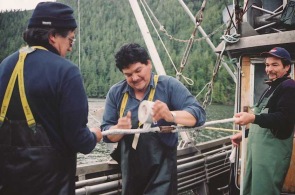
|
|||||||||||
Research So Far
In the summer of 2002, we began systematic sampling of the juvenile sockeye salmon as they migrated through Rivers and Smith inlets. We sampled fish by purse seining, collaborating with the Owikeno and Gwa’sala First Nations whose traditional territories encompass the inlets. We also sampled zooplankton through vertical hauls of bongo nets, took water samples for phytoplankton analysis, and obtained vertical profiles of salinity, temperature, and nutrients in the water. We found a freshwater surface layer over all of Rivers Inlet and a key side channel used by the migrating smolts. By contrast, in Smith Inlet, the freshwater surface layer was |
 |
We investigated the discharge records for the Wannock River, the river down which the smolts migrate into Rivers Inlet. We found an increasing trend in winter runoff and evidence of a trend towards earlier spring freshets which were in turn accompanied by lower adult sockeye salmon returns. We believe that this evidence strongly warrants further investigation.
In the fall, we studied the feasibility of using sediment cores to extract information on past sockeye salmon abundances and ecological conditions in the lakes, and hence the freshwater surface layers. These two lakes present substantial problems for paleoecological work. Both are deep and steep-sided, and Owikeno Lake receives a heavy load of glacial silt. We were nonetheless able to extract intact cores from both lakes and even from Wyclees Lagoon.
Preliminary analyses of a few sections from these cores showed promise. First, mass spectrometry analyses showed that these lakes contained unusually high levels of organic sediment of terrestrial origin, but that even so, d15N concentrations may provide a potentially usable indicator of sockeye salmon returns. Special care will have to be taken to ensure particularly tight standards of quality control for sampling and measurement processes. Furthermore, when these high terrestrial loadings are accounted for, the d15N concentrations in the two lakes appear to be in keeping with values from some of the cores taken from other major BC lakes in a recent Parks Canada study. Preliminary findings show that returning adult salmon have provided a potentially significant, but not overwhelmingly important, source of nutrients to the lakes and freshwater surface layers in the fjords.
We believe that a full analysis of these cores will provide vital evidence for this project. An d15N analysis should provide an index of past sockeye salmon spawning abundances and this isotope analysis, along with cladoceran counts and morphological examinations should provide valuable clues regarding the past productivity (and the potential role of marine-derived nutrients) for these lakes and the surface layers in the downstream fjords.
More details coming soon...
Please read on to
learn more about the specifics of the project -- return to Rivers
Inlet Project Main Page and click on the links at the left-hand side
of the page.